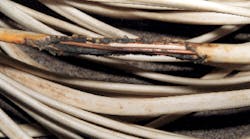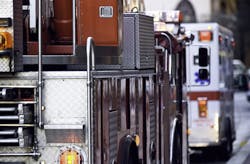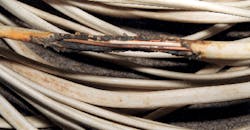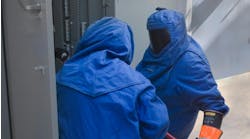When a father and son carpenter team took on a construction project to make improvements to a drainage canal, their first concern was supplying power to their equipment. They immediately installed a temporary electrical panel, fed from a nearby home garage electrical sub-panel.
In the beginning, they placed two portable submersible pumps in front of a temporary dam in the canal to pump water to a diversion channel. At first, the carpenters used an extension cord to supply electric power to the pumps. However, as the project progressed, they had to move the pumps farther away from the temporary service. Instead of using approved power cords, they used a 250-ft-long 2-conductor, No. 10 AWG (with ground), type NM-B cable to connect the panel and pumps. Since this cable crossed an area with heavy truck traffic, they decided to bury it.
Two weeks into the project, the son went down to the canal to help the other construction workers. At the time, the canal held a few inches of standing water. As one coworker recalled, the son went into the water to move a pump to another location. As he bent over to pick up the pump, he suddenly yelled, jerked violently, and fell over face down into the mud and water. Workers ran to his aid, raising his head out of the water. One worker ran to inform the father of the accident. The father called 911 from his cellular phone as he ran to the canal where his son lay unconscious and not breathing. Emergency medical personnel responded and immediately administered resuscitation efforts. They took him to a nearby emergency room where he was pronounced dead.
Within hours of the accident, investigators from the local police and fire departments, as well as representatives from OSHA, arrived on the scene.
OSHA investigators identified several deficiencies in the installation of the temporary electrical system contributing to the accident, including:
- A non-permitted connection to a residential electrical system;
- The neutral conductor of the single-phase service conductors feeding the temporary service was a separate cable from the phase conductors;
- Improper use and wiring connections of a single-phase, 4-wire, 50A receptacle at the temporary panel;
- Improper installation and connection of a 125V, 3-wire, 15A duplex receptacle used for general construction power;
- Improper installation of type NM-B cable in a direct-burial application;
- Absence of an OSHA-approved GFCI device or an assured equipment-grounding conductor system; and
- Inadequately trained employees.
As a result of this investigation, OSHA fined the construction company $52,000.
Forensic evaluation
The attorney representing the construction company called us to review the accident. In response, we assigned an engineer to investigate the case. Through his own on-site investigation, our engineer confirmed the deficiencies noted by the OSHA investigators.
However, he also revealed the following problems: Temporary construction panel. The carpenters set up the temporary panel about 150 ft from the house garage sub-panel. They also tied the panel (equipped with a 2-pole, 50A circuit breaker; a 3-phase, 50A receptacle; and 15A duplex receptacles) with baling wire to metal posts driven only 8 in. into the ground. There was no grounding conductor to the construction panel, nor was there a grounding electrode conductor. The engineer found neither the 50A, 3-phase receptacle nor the 15A duplex receptacles equipped with a grounding conductor. He found the duplex receptacle mounting screws stripped; thus they didn't have a reliable metal-to-metal connection between the yoke and panel enclosure.
Buried cable
The carpenters buried the NM-B, 10/2 cable, with ground conductor, about 6 in. below crushed rock, which workers spread over the area to accommodate heavy construction-related truck traffic. Laboratory examination of the cable found the outer sheath torn and the insulation of the energized conductor damaged. Analysts also found localized heating at one location on the cable.
The engineer concluded the crushed rock most likely damaged the conductor insulation after its installation. Once this occurred, the energized conductor contacted the bare grounding conductor, which in turn energized the outer case of the pump. The pump case became energized because the carpenters did not effectively ground the grounding conductor at the construction panel receptacle.
Accident prevention
Several factors contributed to this accident. However, most (if not all) were avoidable. Poor electrical work practices caused this tragedy. A qualified, competent electrician would have installed the temporary service panel in accordance with NEC and OSHA requirements. And had the son received training in the use of GFCI devices or daily testing of the grounding integrity of electrical equipment, he would have detected and removed the damaged cable. Lastly, had the workers known and used proper first aid (CPR), this story might have had a happier ending.
Foley is President of Technical Consultants Group, Ltd. in Denver. His firm specializes in electro-forensic engineering investigations.





